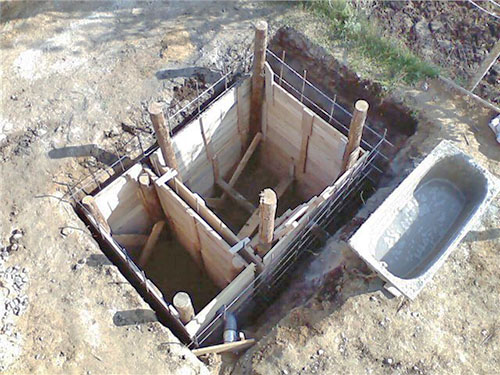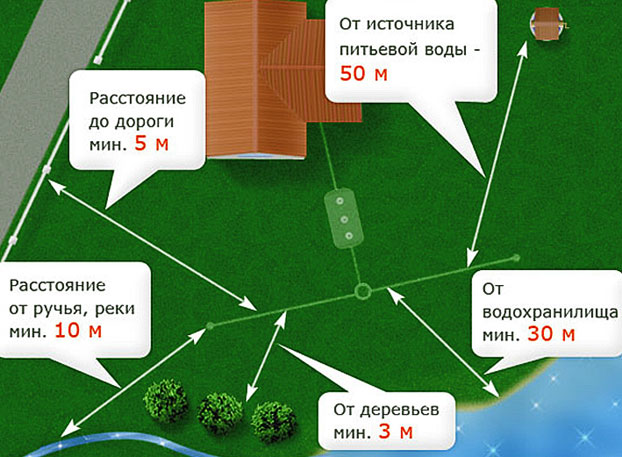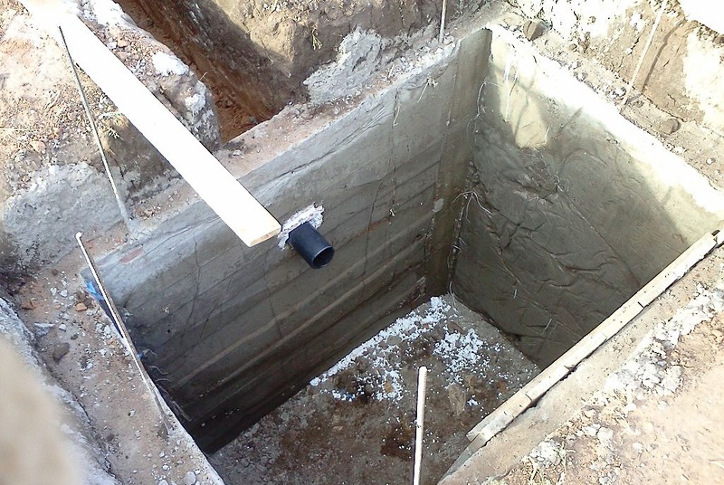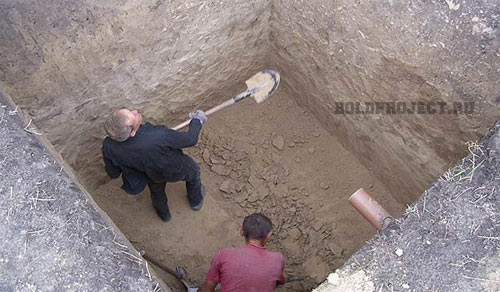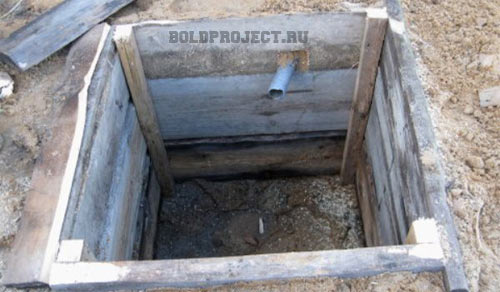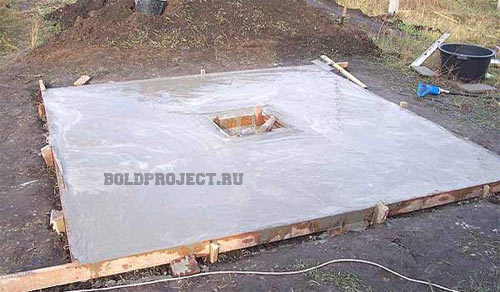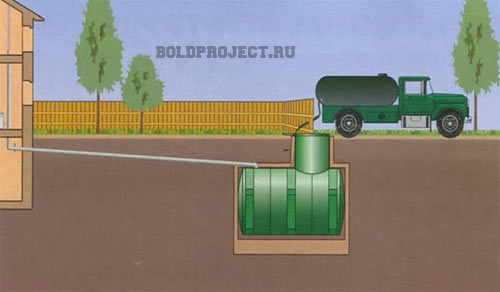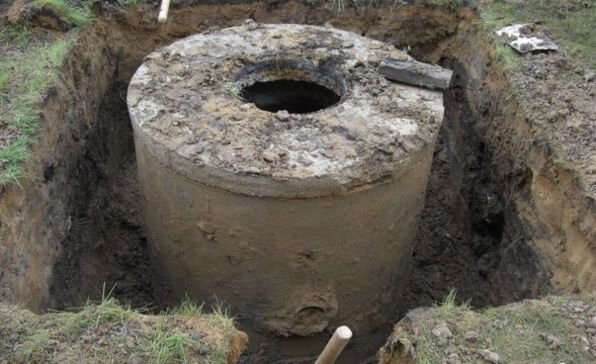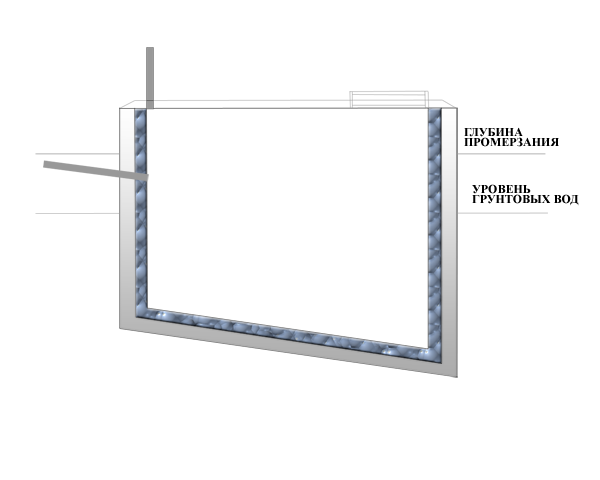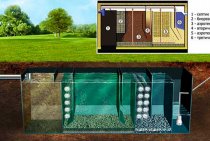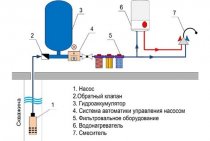Creating a cesspool for a private house with your own hands
If you are engaged in arranging your own site and at home, it is important to consider how a cesspool is created with your own hands. It is a reservoir for waste
There are several varieties, different materials are used. In budget options, long-used car tires are used. Modern septic tanks are also used.
The choice depends on the budget, the characteristics of the soil, the frequency of living in the house. It is much easier if you live in a country house only in the warm season. If this is year-round permanent housing, it is necessary to correctly calculate for large loads.
Types of cesspools and their choice
Cesspools are of the following types:
- Earth bottom tank. It does not require frequent pumping of waste, is a durable, economical option. No need to spend money on maintenance. And the arrangement itself does not require large expenses, it is quite possible to do it yourself. There are some disadvantages. Drainage can disrupt the structure of the soil, adversely affect the soil. Especially if the soil is clayey.
- sealed type. Does not pose a risk to the environment, but requires frequent cleaning. When the owners consume a lot of fluid, it will have to be pumped out almost every week. If the cottage does not have a drain system, this option would be ideal. The most common option for creating such a pit is to use concrete rings that are stacked on top of each other, after which they are sealed. Suitable for any type of soil.
- Septic. The most environmentally friendly and advanced way to build a pit. The filter mechanically purifies water, as a result, the soil is not polluted. It is made of stone, gravel, broken red brick. Water purification is carried out by bacteria. Therefore, you don’t have to worry about environmental friendliness, and efficiency is at the level.
Which option to choose? For infrequent use, choose a hole from the bottom if the soil permits. Sealed tanks avoid odor and contamination, but they are expensive to maintain and require monthly (or, in the case of dishwashers and hot tubs, weekly) cleanings. The septic tank is environmentally friendly, and has no special contraindications. Having decided, we turn to the study of the technology of creating cesspools.
Cesspool made of plastic
A plastic cesspool is the easiest way to create a sewer in a private house.
- The installation location is determined.
- A hole breaks out.
- A concrete cushion is created at the bottom.
- The pillow is covered with a layer of sand 10 cm.
- The plastic container is lowered into the pit.
- Waste pipes are connected to the tank.
- The perimeter is covered with a mixture of concrete and sand (ratio 1:5).
- The upper part is covered with soil.
installation requirements.
- The container should be placed in such a way that there are no turns and bends in the sewer pipes.
- If pipe turns cannot be avoided, make them at right angles.
- The depth of the pipes is 1-1.5 m, to avoid freezing.
- With a high level of groundwater, a plastic container is installed in a concrete well.
Septic tank for sewerage
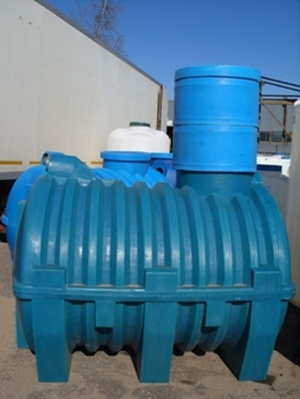
For the operation of a septic tank, special biological products are used that process wastewater. Filtered water from the septic tank is transferred to the main pit, from which it flows into the ground. The slope of the pipes during installation is 15 degrees, the width is 15 cm.The trench is dug in after a control run to make sure the system is working properly.
Construction technology
Bottomless system
If your country cottage is not used year-round, then it is advisable to arrange a cesspool in the form of a container with a filtering bottom (well). This system is suitable for you if the volume of wastewater, according to the forecast, will not exceed 1 m³ per day. More conditions: the type of soil should be sandy or sandy loam, and groundwater should be located at a level not higher than 2.5 m.
Construction is carried out as follows:
Scheme of a toilet with a cesspool.
- When digging a pit, the top layer of earth is scattered over the site. Approximately 1.5 m³ of soil is left for arranging a heat-insulating layer, which will be located above the ceiling.
- Walls and pipes are built at the same time. The first elements are made of brick or concrete rings, the second ones are laid at an angle, this prevents fluid stagnation.
- A pipe is laid on top of the 2nd ring, it should go inside the well.
- Hatches are installed.
- If brickwork was used at the level of the walls, then it is necessary to make a trench (about 30 cm wide), this manipulation will allow the concrete slab to lie both on the walls of the tank and on the ground. Cover the slab with earth to the level of the horizon, and leave the hatch free from soil.
Cesspool device
The principle of operation of a pit in a private house is that wastewater enters a special container through pipes and remains in it until it is pumped out. The volume is calculated by a simple formula: for every 5 people there are 8 m³. If you often take a bath, use a washing machine and dishwasher, then the drain hole will have to be cleaned up to 3 times a month.
Stages of construction of a drain sealed pit:
- The drive is installed first. It can be of different types: from factory-made plastic to sealed concrete.
- Next, it's up to the ventilation outlet, the standard diameter is 10 cm or more. It also needs to be taken out 70 cm above the surface.
- Then the laying of sewer pipes is carried out. Trees should not grow in the path of the pipes.
Pipes must be laid below the freezing depth of the soil. If this manipulation is not possible, then the pipeline will have to be insulated
There are many options for arranging a cesspool, the main thing is that the drain pit does not pollute groundwater; it is also important to regularly maintain the cesspool
SanPiN 42-128-4690-88 requirements and standards, installation distance
On the territory of the Russian Federation, regardless of the region of residence, the requirements of SanPiN for cesspools apply.
When there is no centralized sewer system in a private house, its owners are allowed to locate a cesspool on the site. The main requirement for it is mandatory water resistance. Above the sump there should be a lid to close it and a special grate. You can equip a common drain pit with neighbors.
When a private house is located near a school or kindergarten, then the distance should be at least 20 meters. If you have any questions regarding the arrangement of a cesspool, the owner of suburban real estate should contact the local administrative authorities. But there is a general rule for all private households - the sump should be located so that the distance from the well to the cesspool is 50 meters.
Treatment facilities must be cleaned at least once every six months.
When disinfecting drain pits, a product is used, the components of which are:
- 5% sodium hypochlorite;
- 5% - creolin;
- 10% lime chloride;
- 10% - naphthalizol;
- 10% - sodium metasilicate.
Under no circumstances should dry bleach be used for disinfection.
Installation Features
First of all, select the appropriate location for the system. This is not so simple: it cannot be placed close to the house, long sewer pipes are also undesirable.The cesspool should allow the sewage truck to drive freely.
The location of the structure in a private house is regulated by norms and rules. Here are the main provisions:
- from the house to the cesspool there should be a distance of 5 m or more;
- from the groundwater layer to the bottom of the pit - from 1 m;
- from the fence to the edge of the pit - from 1 m;
- from the source of drinking water to the system with clay soil - more than 20 m; with sandy loam - more than 50 m.
Brick cesspool.
By following these conditions, you will ensure a long service life of the cesspool. As for the volume of the tank, the scheme here is as follows: 0.5 m 3 per person. It is worth saying that the calculation is an individual matter. If your site is located on clay soil, then the filtration rate will be low, in the first year after construction, the system will cope well with waste, but then, as the soil becomes saturated with fats, the filtration capacity will decrease. Therefore, it would be advisable to provide a system of drains with a certain margin of volume.
When the volume of the cesspool is determined, start laying pipes. Be sure to observe a slope of 3% (this will be approximately 3 cm per 1 m of pipeline). The longer the pipes, the smaller the slope. And one more thing - the cesspool system is of 2 types:
- sealed system (when a plastic container is buried in the ground);
- a hole without a bottom.
Homemade septic tanks
A septic tank, or a septic tank, is a container consisting of a single sealed housing (usually plastic), divided into several sections (for example, as in the figure - A, B, C), an intersection separator, a sewage supply pipe and a cleaned discharge pipe.
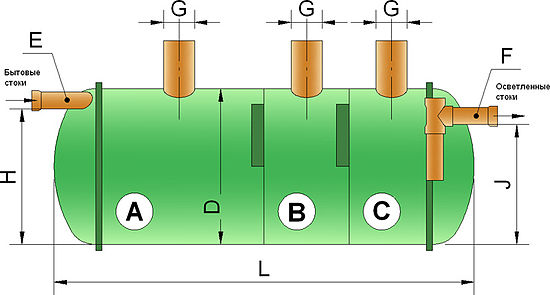
You can build such a complex structure with your own hands, but this will require considerable financial investments. The essence of the work on the arrangement of the cesspool-septic tank:
- It is necessary to buy two or three containers made of special plastic - they must be sealed with outlet holes to the outside.
- Between these containers you will need to install overflow pipes - they must also be available. Moreover, they will need to be installed under a slope.
- In the first tank of the septic tank there will be a small filter - they are sold in stores and have a special marking “for a country septic tank”. This filter will be located at the outlet of the pipe leading to the second container.
- In the second compartment of a complex cesspool, bacteria will live that process waste and turn dirty water into practically clean water - at least it can be used to water the garden and the garden, and wash the car.
- The third compartment is installed at will - it is needed to collect already purified water, but even without it the septic tank will be fully operational. The only clarification: in this case, a drain valve will need to be installed in the second tank - it will be necessary to extract purified water somehow!
Experts say that the most practical thing is to invite professionals to equip the cesspool. But it is quite possible to do it yourself, which will save significant financial resources. If there is no construction / engineering education, and experience in carrying out any construction work is minimal or completely absent, then it is better not to risk installing a septic tank yourself - specialists will do this with a quality guarantee.
Cesspool cleaning
Fecal pump
A fecal pump is better to use a surface one. Only the hose is immersed in the pit, the installation itself is located on the ground or in a separate room.
Submersible-type fecal pumps with grinders are on the market.
The submersible pump is lowered into the cesspool. This unit is impractical to use for periodic pumping. Since for the most part he is constantly in the septic tank. Every time it is just inconvenient to get it and clean it.
Submersible pumps with a grinder operate autonomously, which is very practical when the septic tank is often overfilled. As soon as the level of drains rises to a certain level, the unit turns on automatically.
Container for waste that will later need to be removed
The tank for storage and transportation of effluents must be airtight with a tight-fitting lid. It is great if it is of a large volume, in which case several pumpings can be made into it. Removal and disposal will need to be done less frequently.
For storage of drains, in most cases, black plastic tanks are purchased.
Black barrels are designed to store liquids outdoors. They are of high strength. Withstand temperatures from -40 to +50. Resistant to aggressive environments, and have high tightness.
How to pump out silt from a drain hole
Before you start cleaning the septic tank, it will not be superfluous, 2-3 days before pumping out, add a special bioactivator to the pit. The tool is not expensive, but the benefits of it are huge.
Leading drugs: Dr. Robik 109, Dr. Robik 409 (dissolve even fossilized sediment), BIOSEPT, DEO TURAL (can be used at any temperature and for any septic tank).
After all the preparations, you can start pumping.
If a submersible pump is used, then the outlet hose is inserted into the container and pumped out.
If the pump is a surface pump, then a suction hose is lowered into the pit to the bottom, the pipe to the outlet is lowered into the prepared container.
The amount of content in the septic tank should be checked periodically.
Pump out a cesspool without a pump
The process is laborious and unpleasant. You can't clean up alone.
Need
- sealed suit
- Respirator
- Gloves
- Bucket
- Staircase, if the septic tank is large.
- Rope
- shovel
The stairs descend into the pit. With a shovel, sludge is collected in a bucket. With the help of a rope, the contents rise to the surface, pour out into a compost pit or container.
And so on until the septic tank is completely empty.
The procedure is not only unpleasant, but also dangerous.
Toxic fumes from sediment can cause unconsciousness.
If you fall into the mud, you may drown.
You can pump out on your own not only a single-chamber septic tank, but also consisting of two and three tanks.
Do it better with a pump
- The first reservoir is pumped out, in which the effluent settles and the primary sediment settles.
- Second camera. If a biofilter is present, then it must also be cleaned. It is not necessary to empty the second tank completely, it is enough to remove the sediment.
- Further, the third chamber is freed from silt.
It is worth noting that due to the use of bacteria, the amount of sludge in septic tanks is significantly reduced. The precipitate becomes liquid, without large particles.
Cesspool Rules
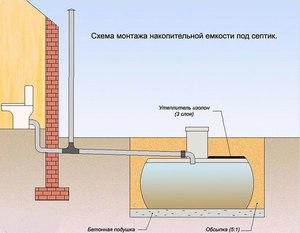
The distance from the cesspool to other objects on the site is regulated by the rules and regulations.
Basic device rules:
- The distance from a private house to the sewerage system is at least 5 m.
- The distance from groundwater to the bottom of the pit is at least 1 m.
- The distance from the fence to the edge of the sewer is not less than 1 m.
- Distance to sources of drinking water with different types of soil: clay - from 20 m, sandy loam - from 50 m, loam - from 30 m.
By correctly determining the volume of the cesspool, you will provide it with a long service life. When calculating, proceed from 0.5 m 3 per person. But these figures do not take into account the characteristics of the soil.The absorption rate in clay soil is low. Therefore, the first year the sewer will normally cope with waste. But, the more the soil is saturated with various substances, the filtration capacity will deteriorate.
For better functioning, make a cesspool with a margin (for 3 people 6 m 3). This will increase the service life and save money on calling a sewage truck.
After determining the required volume, pipes are laid. The slope should be 2-3 cm per meter. The longer the length, the smaller the slope.
Cesspool of rings
A cesspool made of concrete rings is a very popular solution for a country house.
- Durability (the well serves up to 100 years).
- Concrete is not subject to rotting and tolerates the fermentation process well.
- Installation is simple and inexpensive.
- Groundwater is not polluted.
- It does not depend on the type of soil and the level of groundwater.
Stages of installation of a cesspool from the rings:
- A hole is dug out, sufficient for concrete rings.
- The bottom is filled with concrete. In the proportions of crushed stone to cement 6:1. The solution must harden within 7 days. If the pouring takes place in hot weather, then the concrete surface must be moistened periodically, otherwise cracks will appear and there will be no required strength.
- After the concrete has hardened, we begin the installation of the rings. You can't do without a crane. Some sellers provide a rental service for lifting equipment. The rings are gently lowered to the concrete bottom. After installation, the seams are insulated with sealants (liquid glass, rubber-based seals). It is best to use liquid glass, mixing it with cement mortar and applying it to the joints between the rings. Internal insulation is quite enough, but if your site has a high level of groundwater, then you need to perform an operation from the outside. For ease of installation, buy rings that have a "lock". When using conventional ones, the structure will have to be fastened with metal brackets.
- A concrete floor with a hole for a hatch is mounted on the upper part of the ring.
How to arrange an airtight cesspool
Many believe that a sealed cesspool is an extra problem in the form of a more complex arrangement process and the need to regularly pump out accumulated liquid waste. But if the site is located in a region with high groundwater, then such a design is the only option for arranging sewage.
What you need to consider when working with a cesspool of an airtight type:
- The walls of the pit must be laid out with bricks without leaving gaps, as is the case with an absorbent structure.
- It is advisable to plaster the brick walls with cement mortar.
- The bottom of the cesspool must be cemented, and before that, waterproofing "procedures" must be carried out. For sealing, you can use liquid glass.
- The lower concrete platform needs to be reinforced - you will need to lay a special concrete mesh on the bottom so that it does not “drown” in the solution, it is installed on pegs.
- You can completely seal the cesspool with bitumen or cement mortar.
- When laying bricks or sealing the pit with bitumen, a hole must be made for installing / connecting a sewer pipe.
It should be noted that the arrangement of a cesspool in a private house is not a quick matter. At a minimum, you will need to wait for the concrete pad to dry completely. But the absorbing structure is made much faster, because when sealing, it will also be necessary to wait for the mortar to solidify for laying bricks.
If you plan to make a cesspool of concrete rings, then you can take advantage of special offers on the market - manufacturers offer to purchase a "Lego constructor" - concrete rings, the bottom and cover of the pit. In this case, the time of work is significantly reduced - there is no need to independently pour the concrete pad at the bottom of the pit and make a cover.
Do-it-yourself construction of a cesspool
You need to start this process only with earthworks, which, accordingly, are carried out using mechanisms. Then we clean the walls, and also make the bottom (it should have a special slope, directed, as it were, towards the future hatch). Often the shape of such a pit has the shape of a rectangle. So here are the recommended settings:
- Depth - about 1.5 m.
- Width - about 1 m.
- And the length is calculated individually in each case.
Next, we fill the bottom with sand (about 15 cm), after which we lay the concrete to the same thickness. Then we install a concrete screed (about 4 cm). It must be remembered that the bottom can also be laid (naturally, at an angle) with a ready-made concrete structure. But if the walls are bricked, then you will need tightness - this can be achieved through a clay castle.
Laying should be done in half a brick, fixing everything with cement mortar. Next, you can lay the plaster, which can be additionally fixed with metal reinforcement. Finally, you can still treat the surface with mastic, which will prevent further seepage of waste into the ground.
We equip the floor
For this purpose, we may need beams or ready-made structures - poles, concrete, and so on. In this case, the thickness of the side overlap will be 50 cm. Do not forget to leave a hole for the hatch!
When we install the ceiling, you can cover it with insulation, for example, roofing felt. After that, we pour a 30-centimeter layer of clay or earth.
So that the waste does not freeze, and in the summer they do not exude incense, a double hatch should be installed (that is, it will have two covers). The first of them will be located in the same place as the overlap, and the second - approximately on the ground line.
A void is formed between them, which will need to be filled with slag or some other substance. Moreover, the second cover must be waterproof.
Where do we place the cesspool
There are many options for this, but the most popular are the following:
- In the heart of your suburban area. If so, then it is worthwhile to carefully consider the passage to the territory of the site of sewage equipment.
- On the border area of the site. This option is simpler, because the equipment will be able to pump out sewage even from the street without stopping at the site. At the same time, pipes need to be laid much less.
Cesspool without a bottom
It is worth saying a few words about this option. It is more profitable, because less materials are needed, installation / dismantling will take place very quickly, and it is very easy to operate such a pit. But at the same time, there are a number of disadvantages:
- First of all, such a pit is dangerous for the environment.
- Groundwater should be at a lower level than the bottom of the pit.
- This option is not suitable for sewers with large volumes.
- The blessing cannot be hidden.
And finally, the last thing: do not confuse a cesspool with a compost pit that has slightly different purposes.
Notes
- ↑ (Retrieved February 29, 2016)
- ↑ (Retrieved February 29, 2016)
- ↑ Yam // Explanatory Dictionary of the Living Great Russian Language: in 4 volumes / ed. V. I. Dal. - 2nd ed. — SPb. : Printing house of M. O. Wolf, 1880-1882. - T. 4. - S. 698. (Retrieved February 29, 2016)
- ↑ Yam, a village on the post road // Encyclopedic Dictionary of Brockhaus and Efron: in 86 volumes (82 volumes and 4 additional). — SPb., 1890—1907.
- (Retrieved February 29, 2016)
- (Retrieved April 1, 2010)
- Yam // Explanatory Dictionary of the Living Great Russian Language: in 4 volumes / ed. V. I. Dal. - 2nd ed. — SPb. : Printing house of M. O. Wolf, 1880-1882.
- Vasilenko N. P. Orders // Encyclopedic Dictionary of Brockhaus and Efron: in 86 volumes (82 volumes and 4 additional). — SPb., 1890—1907.
- (Retrieved February 29, 2016)
We calculate the dimensions of the depth, width
The most important thing to keep in mind when calculating is the number of people living on your site. After all, as sanitary standards say, for each person there is 0.5 m3 of the volume of the entire cesspool.
In addition to the already mentioned groundwater level, it is necessary to think about the depth to which the liquid will freeze through. For example, in the central regions of the Russian Federation, such a depth can be 1-1.2 meters. The volume of the pit will directly affect the frequency of its cleaning (which, by the way, is best done at least twice a year).
Now let's talk about the capacity of which the pit will consist. Often, rings made of concrete, wood or ordinary brick are used for this. But progress, as they say, does not stand still, and in recent years containers made of plastic or metal, having a volume that suits us, have become increasingly popular.
Such tanks must be buried in the ground in the place we need, they cover it. Moreover, it is necessary to equip a special hatch through which sewage will be pumped out.
A responsibility
When constructing a cesspool, it is necessary to fully comply with the rules and regulations for this type of structure. If any sewage element is installed incorrectly, leakage and contamination of the territory, as well as the water source, may occur. For causing serious damage, liability is provided, up to criminal.
Regardless of the type of cesspool, it should be developed by a specialist who will not only take into account all factors, but also ensure that all building specifications are observed during the construction process. This is the only way to be sure that the sewage system is environmentally friendly and will last a long time.
Seleznev Gennady Antonovich
We take into account the norms and rules of arrangement
To achieve a certain level of security, you need to think through all the nuances. Otherwise, there is a risk of creating a threat to the landscape, the arrangement of a private house, and the health of residents. The following important points are taken into account:
A well with water should be at least 30 m from the pit. The level of the pit should be lower. This avoids problems with drinking water contamination.
With a large amount of waste, it is not allowed to make a pit without a bottom. The limit established by the norms is 1 cubic meter of waste per day.
The pit should be in a place where a sewage truck can easily drive up. The distance should be closer than 4 m. Depth - no more than 3 m, otherwise the hose will not be enough to pick up all the waste.
It is necessary to achieve the optimal tightness of the lid closing
Especially important for the winter period. It is recommended to use heaters.
Compliance with state sanitary standards will avoid serious problems. A self-made sewer cesspool should not harm the soil, have leaks in unacceptable places, and have an unpleasant odor.
Arrangement of sewerage and drain pit of a private household
The comfort and coziness of a country house largely depends on the equipping of residential real estate with life support systems. The removal of polluted wastewater among the engineering communications of individual buildings occupies a key position.
To equip an autonomous sewage system, an internal wiring is installed, an external highway is laid, a septic tank is installed, or a drain pit is built in a private house. The device of the last link in this chain has a number of preferences: the cost part is low, and you can build a cesspool yourself without the help of specialized teams.
Additional requirements for the arrangement
- In addition to the requirement, what should be the distance between the well and the cesspool, there is another important point - this is the tightness of the treatment plant so that sewage does not poison the soil and aquifers, since in this case the environment will be harmed.
- The building materials used in the arrangement of sedimentation tanks (bricks, boards, blocks) must differ in density
- Drains should not be allowed to be above the mark of 35 centimeters from the ground surface, since then the owner of the property himself is unlikely to be able to cope with the negative consequences.
There are also requirements for the distance from cesspools to utilities:
- from the water supply from asbestos-cement pipes to septic tanks and drain pits, the distance should not be less than 5 meters;
- when using cast-iron pipes with a diameter of not more than 200 millimeters - 1.5 meters;
- in the presence of pipes made of cast iron with a diameter of more than 200 millimeters - 3 meters;
- to gas pipes - more than 5 meters.
To prevent the unpleasant smell from disturbing the residents, it is necessary to observe a 5-meter distance from the building to the cesspool. The sump should not be located closer than 1.5 meters to the boundary of the site.
Types of cesspools
There are two types of cesspools:
- Sealed.
- No bottom.
When choosing the type of structure, one should focus on the composition of the soil of the site. Cesspools, with concrete, brick floors and walls, created by a waterproofing layer, are more complex structures. Such storage tanks prevent sewage from entering the soil. The volume of the pit can be any, calculated by the amount of daily volume of domestic wastewater, the possibility of regular cleaning. It is advisable to use special biological activators in the operation of sealed storage tanks. They will speed up the cleaning process, eliminate the accumulation of odors.
In areas with sandy soil, simpler structures can be used in the sewer system. In such pits, the bottom is not covered with brick or concrete. It is covered with a layer of rubble. Wastewater, falling into such a pit, seeps into the soil, undergoes natural filtration by layers of sand. Such a structure can only be used with a small amount of liquid. If a large amount of wastewater enters a cesspool without a bottom every day, aerobic bacteria will not be able to cope with their cleaning, which will cause environmental pollution. The maximum volume is 1 m³ of liquid per day.
Construction of a sewage tank
The design of the sump depends on the typical characteristics of the tank and the material used in its construction. The algorithm of construction work includes digging a pit, the depth of which is determined by the level of groundwater. As a rule, it does not exceed 3–4 m.
The second stage is connected with the preparation of the bottom. It is carried out even when an impervious caisson made of plastic or metal is installed. Filtration pits require filling the bottom with a layer of crushed granite with a combination of pebbles of large and small fractions.
Limestone rock is used less often, as it does not have sufficient strength and predisposes to rapid silting. The bottom of the hermetic wastewater receiver, based on the consistent installation of reinforced concrete rings, is poured with a layer of concrete 15–20 cm thick, giving additional strength to the metal mesh or reinforcing strapping.
The maximum excavation of sewage when pumping out a cesspool requires a slight slope of the bottom surface of the drive. This circumstance allows the sewer machine to completely pick up the silty suspension. The settling tank device assumes a cylindrical or rectangular structure with a ceiling placed on top with a technological hole for pumping out.
The construction of a brick pit allows a conical configuration in the form of a bottle with a thin neck, on which an inspection hatch is attached. The entrance of the sewer main is below the level of soil freezing for a specific climatic zone, otherwise the engineering communication is additionally wrapped with heat-insulating materials. The branch pipe is launched inside and crowned with a branch, which excludes the destruction of the opposite wall by the jet of the utilized liquid.
For safe and trouble-free operation, the drain pit in a private house is equipped with a ventilation duct. The hood prevents the concentration of toxic and explosive vapors in the storage tank. Communication with the atmosphere levels the vacuum that occurs in the sewer pipeline during intensive use, which prevents silting of the drain line.
The height and diameter of the fan pipe depends on the size of the cesspool and the wind rose.The choice of a place for the construction of a sump, regardless of its design, should exclude flooding by storm and melt water. The volume of the working chamber of the drive is calculated based on regulatory requirements - 1.2 m³ per family member. Thus, for a family of four people, a drain pit with a capacity of five cubes is installed.
Cesspool device options in a private house
When building a new house, you need to think about where and how to make a cesspool. Of course, a city dweller does not even think about the organization of a wastewater system, another thing is the owner of a private house, this problem is from the category of “pressing” for him. It is clear that for a comfortable stay, the sewer structure must function properly and clearly.
Cesspool depth device.
The cesspool system, with the proper approach and using high-quality building materials, will last a long time.
Before proceeding to construction, consider how it will be cleaned and how much volume you need.
We take into account the norms and rules of arrangement
To achieve a certain level of security, you need to think through all the nuances. Otherwise, there is a risk of creating a threat to the landscape, the arrangement of a private house, and the health of residents. The following important points are taken into account:
A well with water should be at least 30 m from the pit. The level of the pit should be lower. This avoids problems with drinking water contamination.
With a large amount of waste, it is not allowed to make a pit without a bottom. The limit established by the norms is 1 cubic meter of waste per day.
The pit should be in a place where a sewage truck can easily drive up. The distance should be closer than 4 m. Depth - no more than 3 m, otherwise the hose will not be enough to pick up all the waste.
It is necessary to achieve the optimal tightness of the lid closing
Especially important for the winter period. It is recommended to use heaters.
Compliance with state sanitary standards will avoid serious problems. A self-made sewer cesspool should not harm the soil, have leaks in unacceptable places, and have an unpleasant odor.
